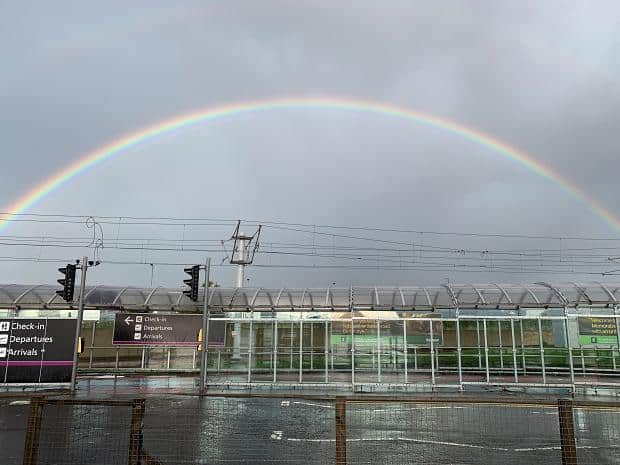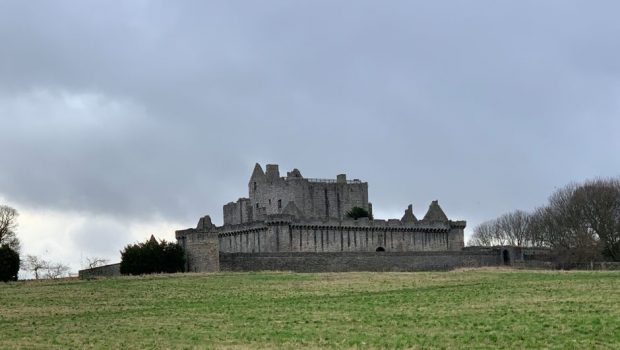Getting There
Covid had previously impacted our 2020 Travel Plans, so when we saw a window of opportunity to do some travel in France we jumped at it, but we were also a bit wary of booking anything.
We’d spent so long making the original plans and then having to go through the rigmarole of cancelling everything that we wanted to be as sure as possible before making more plans. It didn’t help that after booking things the UK government reacted to the higher Covid rates in France and imposed a 14 day self-isolation rule on people returning from France. Ange and I both work from home so that wouldn’t be too problematic, but there was talk about France retaliating in kind which would rather spoil the trip if we had to stay in one place for fourteen days.
We’d found a flight from Glasgow to Jersey which necessitated an early morning train ride, but the low appetite for travel meant that once we arrived at the airport, we breezed through security and were very ably looked after at the only lounge that was open.
Jersey
We had a compulsory Covid test on arrival and while it wasn’t the “let’s see if we can hit your brain via your nostrils” sort of test, it was more of a “let’s see if we can make you throw up by hitting your gag reflex” sort of a test. Still, not the worst kind of medical test you can get, so not worth worrying about it.
We then headed to St Helier, the capital of Jersey, via bus. As we left the interior and started to inch our way around the coastal route in heavy traffic, we could see how St Helier’s Bay in Auckland got its name: it shared the same gently sloping beach and golden sands.
We checked into the Royal Yacht Hotel and then explored the town a little. The original plan was to dash across the island and check out the World War Two tunnels built with slave labor, but the miserable weather, early start and lack of public transport sapped us of the necessary enthusiasm so instead we amused ourselves in town – checking out where the ferry building was so that we would be able to find it the next morning.
We’d managed to arrive in the year of the 75th anniversary of liberation from the Nazi invaders, but the strong focus on these events weren’t restricted to just those celebrations: the main town square was Liberation Square, the bus station was Liberation Station and the local shopping centre was Liberation Wharf.
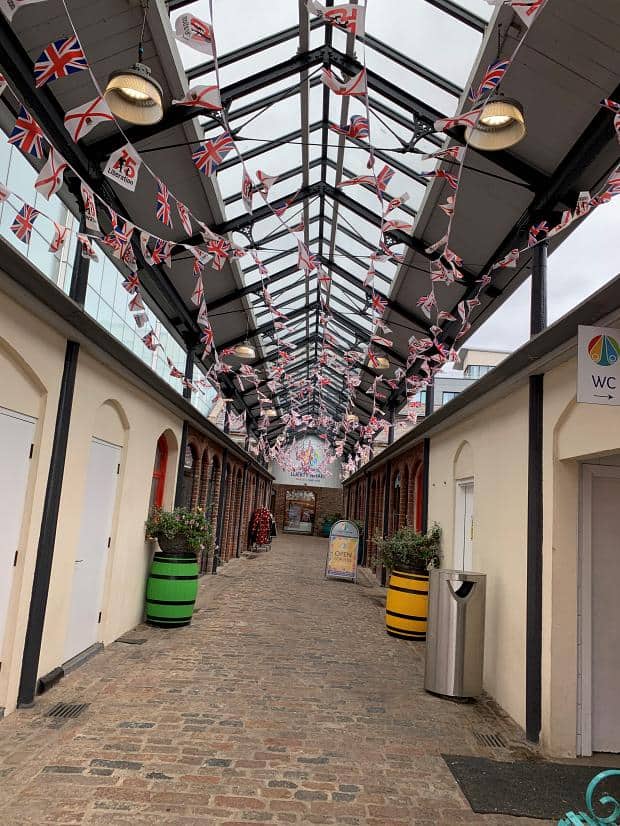
The next morning we headed to the port and checked in for the ferry ride to the French mainland. We were about fifteenth in the queue, and were waved through past the security checkpoint. I paused, confused, expecting everybody to have to go through the checkpoint. After they told me the third time to keep going, it finally registered that they just took the first ten or twelve people to check and the rest, well….
The people behind us joked about it – “I guess we don’t look like criminals” a reference to the fact that everybody was masked like highway robbers from the Wild West. We were still joking about it when a group of four men walked through the waiting area to the main doors.
I looked over at Ange and her eyes were wide. She’d noticed, as I had that two of them had their jackets over their arms in an attempt to hide the fact that they were heavily manacled. Not the handcuffs you see on TV, but thick chains like you see to lock up motorbikes. One of the non-handcuffed escorts headed back, while the two prisoners and their other escort were let onto the gangway by a ferry staff member. He then turned to the room at large and invited all other guests to follow him down to the ferry. Those who had seen the manacles were a little slower than those who hadn’t!
Saint Malo
I spent most of my time on the two hour ferry ride chatting with a local who split his time between Jersey and Normandy. Him and his wife (and two dogs) were driving to their house and said that normally they’d offer to drop us off at Mont Saint Michel, but that the car was packed with dog accoutrements and luggage. I thanked him for thinking of us, but said we were hoping to have a look around Saint Malo.
We could keep an eye on the prisoners and their escort who surprisingly were laughing and chatting quietly. Our new friends indicated that they occasionally had French people who came over and got into trouble and the local police would just send them back to France and say “don’t come back”. That satisfied my question about why Jersey (part of UK) would send prisoners to France rather than maybe back to mainland UK.
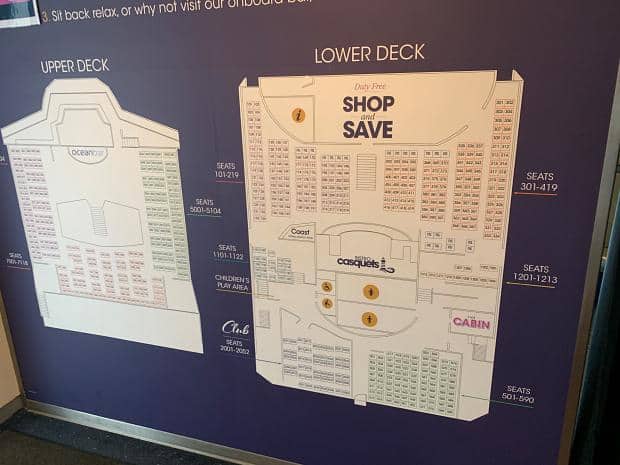
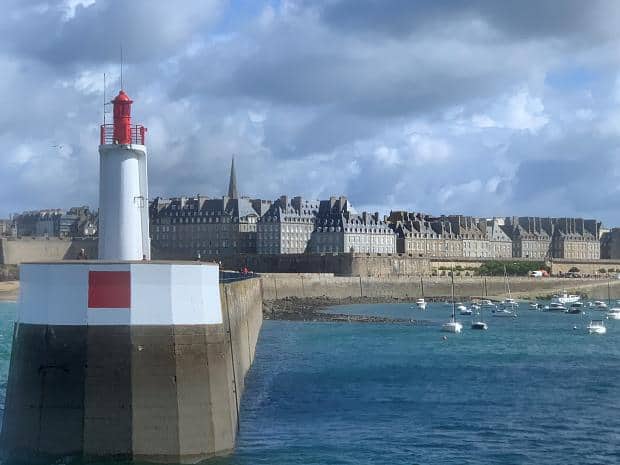
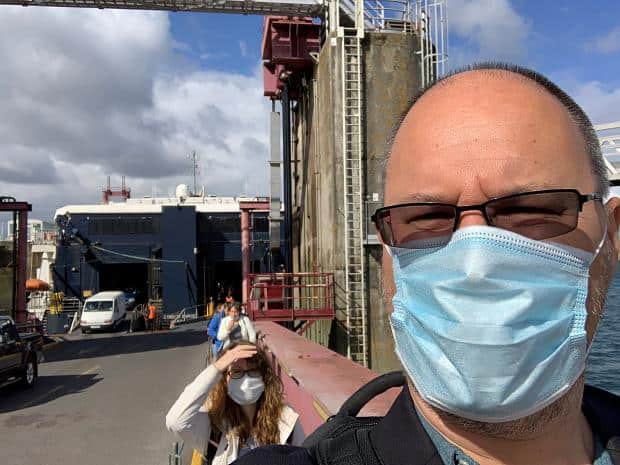
As we came into the port, we could see the walls around the old town which had been recommended to us. So we made sure we were some of the first off the boat, making our way onto the first of the waiting buses which ferried us to the passport check where they stamped Ange’s passport and casually flicked their eyes at mine and then we were in France.
We made our way into the interior of the city through the thick walls and into a very picturesque old town with stone buildings and cobbled streets.
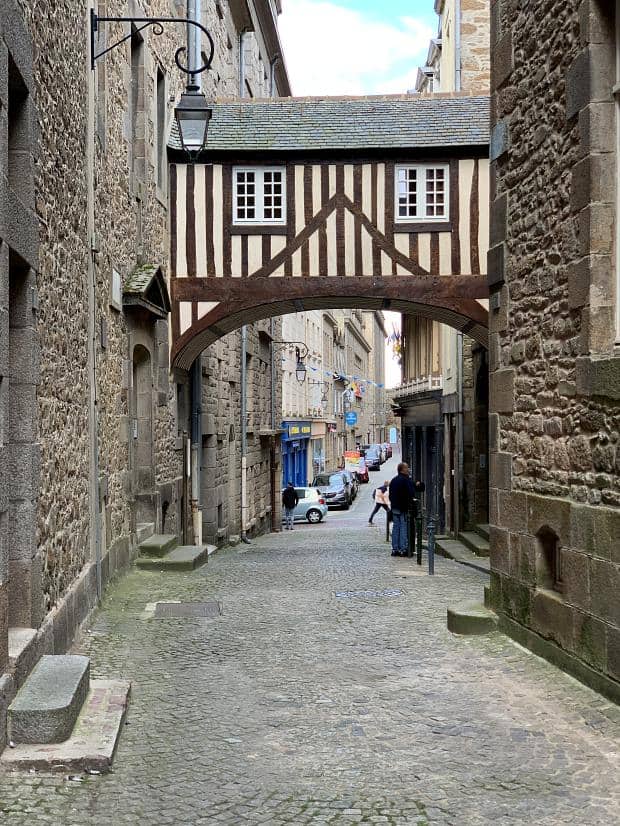
Breakfast at the hotel was a while ago, so we endeavoured to find something to eat, and happened upon the main town square surrounded by tourist trap restaurants.
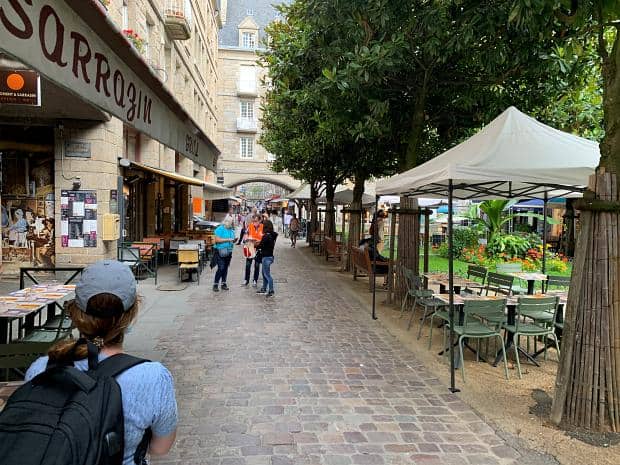
We selected one where we could sit inside away from the smokers, partially attracted by the giant teddy bear out the front, and got stuck into the first of many baguettes we would have over the course of our trip.
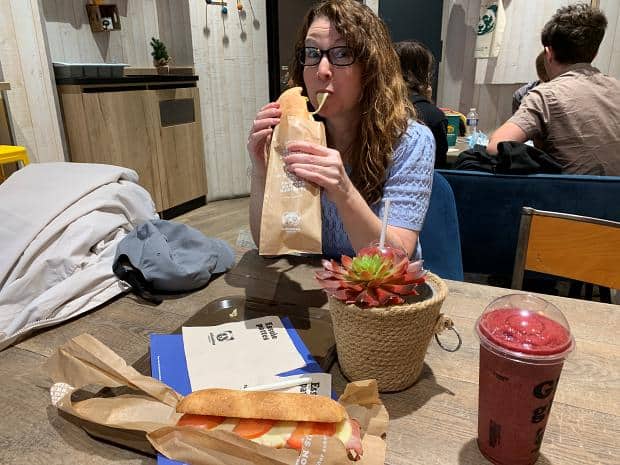
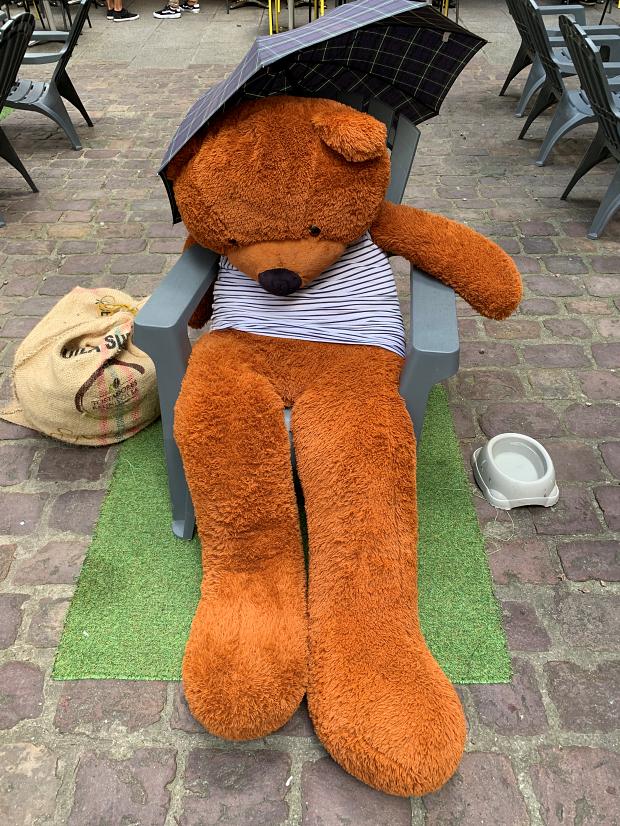
Suitably satiated, we headed towards the wall which encircled the town. The staircase which we chose to access the battlements had a bit of a story. It was the kennels where the guard dogs were housed. At night they’d close the gates and release the dogs. The dogs wouldn’t be fed during the day so they were naturally quite hungry – an incentive to catch anyone out and about after curfew.
I assume that they were fed in the morning after running around all night. The practice was stopped after a military officer was returning after curfew and was caught and mauled by the dogs!
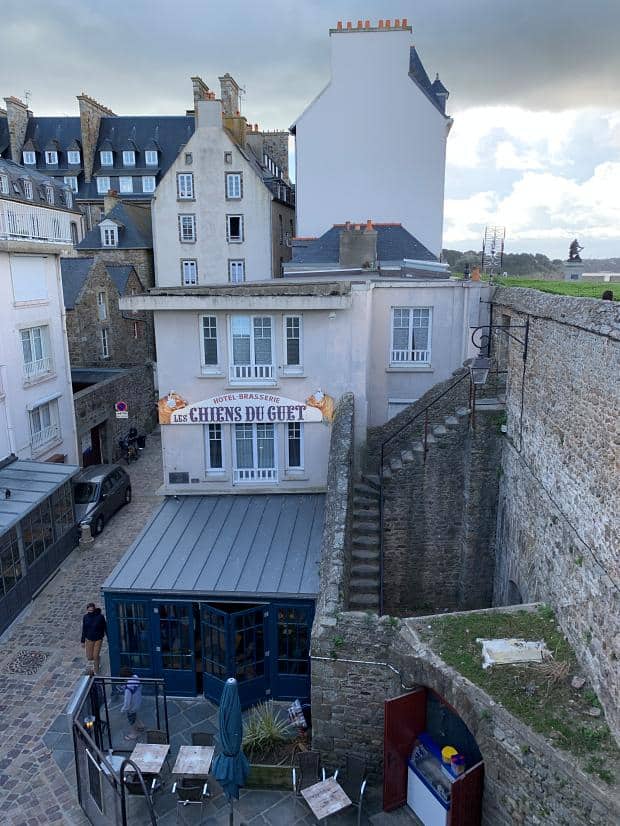
The views from the wall were quite lovely, islands and forts from Napoleonic times scattered around. The sun was out which explained why some kids were swimming in the lido – some even diving from the diving board.


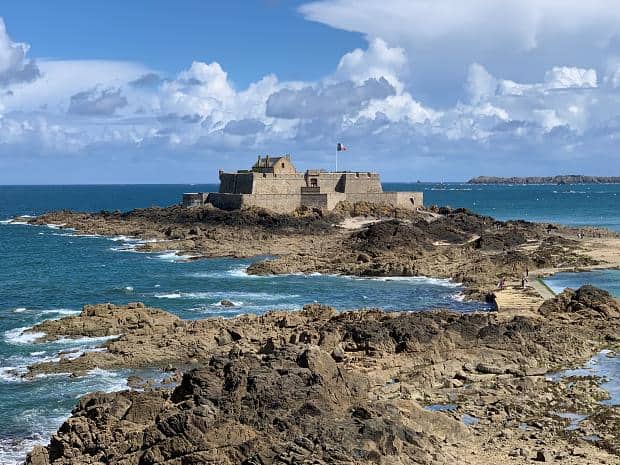
While the sun was out, there was still a fair bit of wind, and the horizon was a wall of clouds of various hues.
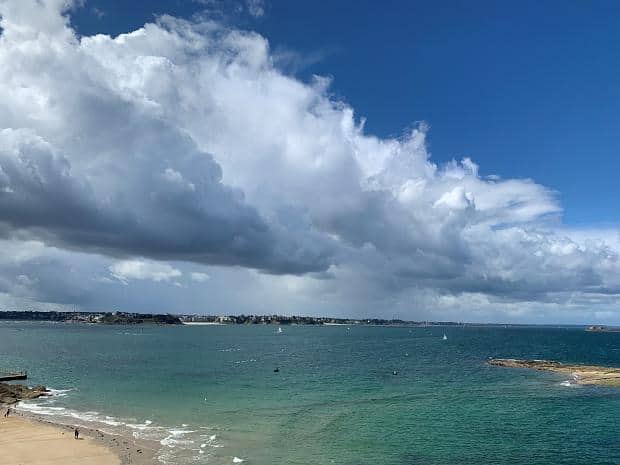
The walls were very thick and occasionally a military building of some description would appear behind it – an obvious location for more cannons.
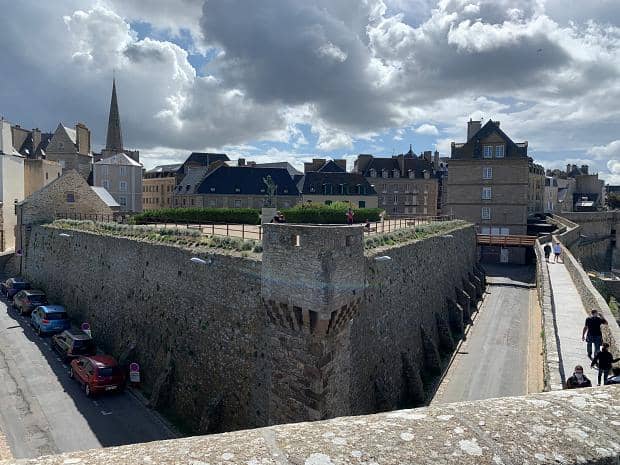
Eventually the path lead to a gate in the walls and we headed down on to the beach. A whole lot of logs had been driven into the sand to protect the town walls against the waves, making a denuded forest with a ten foot wide no man’s land.
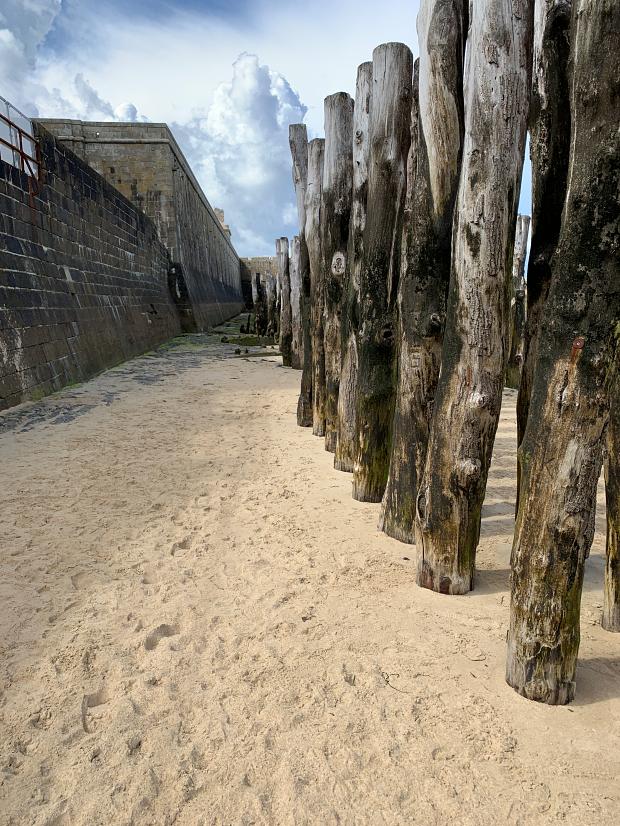
We made our way around the walls until we came across the second cluster of restaurants, these ones encircling the town square in front of the Town Hall. We climbed back onto the ramparts, and enjoyed the unique perspective – one restaurant’s glass conservatory roof forming a fascinating insight into what other people were eating.


I was just commenting how the clouds were turning dark when the temperature abruptly dropped. and the heavens opened. We dashed to the shadow of a turret along the walls which offered a slight respite.
When it looked like the rain had set in for a long time, Ange got out her umbrella and we headed down the stairs through a cascade of water to stand in the gate which passed through the walls which provided much more cover. Not long after we made ourselves comfortable, the rain stopped, just as suddenly as it had started.
We completed the loop of the town on the top of the walls, marvelling at the darkness of the storm clouds not a kilometre away as the rain continued its way along the coast.
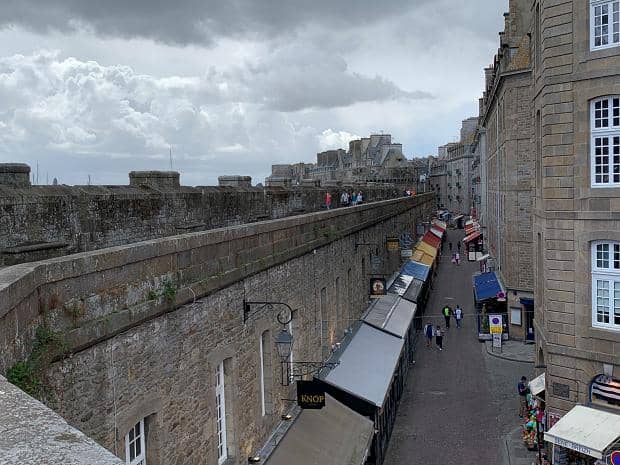

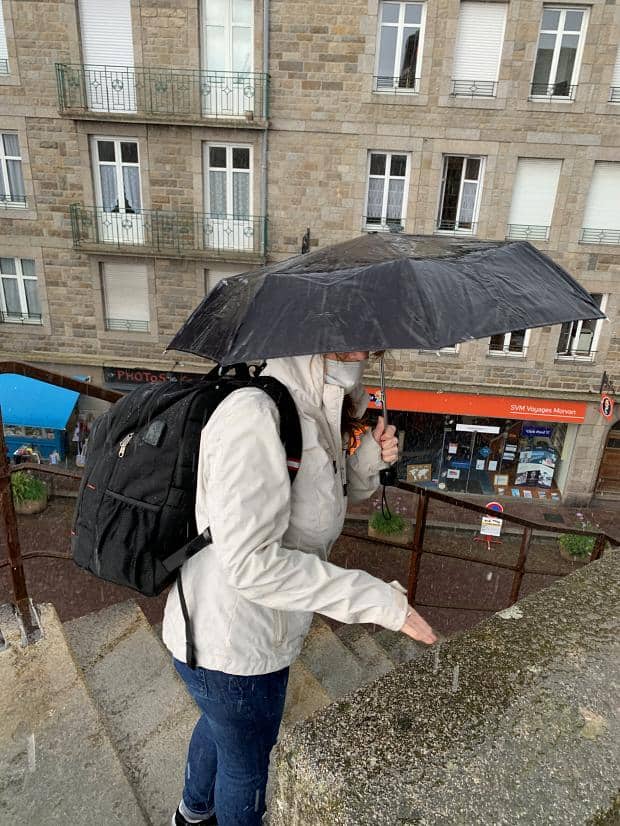

From this corner of the walls we could see the Condor Ferry which had takes us across the short section of the Channel between Jersey and Saint Malo.
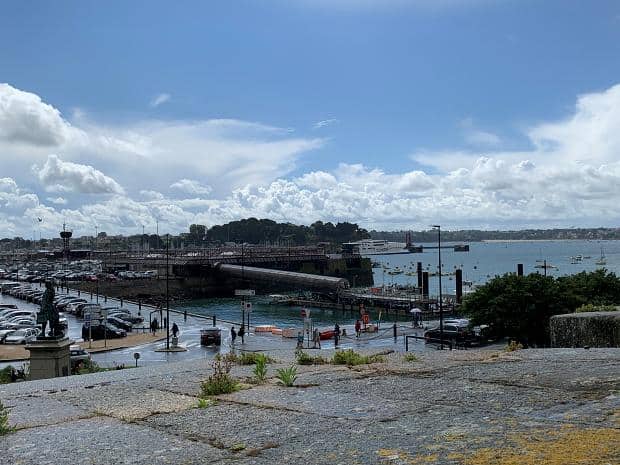
We’d seen as much of the old town as we could and so headed towards the train station, Google Maps navigating the way for us but a yacht needing to come into the harbour meaning the road was raised for them to get by.
It was a six minute detour if we went the long way so we waited patiently with a growing group of fellow tourists and locals alike (the joke was that you can tell the locals because they’re the ones carrying a baguette or two).
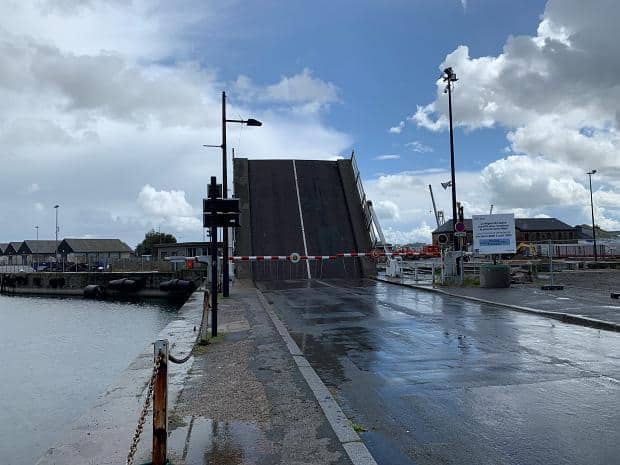
Before too long the yacht passed through, the road was lowered and we carried on our way, finding a cafe near the station and having a coffee while waiting for the train.
We had a forty five minute layover in Dol de Bretagne so endeavoured to find something to eat again. That ended up being a twenty minute walk through the town to a supermarket where everything was organic, a five minute scramble to find something we could eat without cooking, followed by a fifteen minute jog back to the train station in the rain.
Mont Saint Michel
We checked into our AirBnB and the next morning we headed out nice and early to walk to the free shuttle which would take us to Mont Saint Michel.
The AirBnB was actually in Beauvoir, on a hill overlooking the bay, and so five minutes from the room we could actually catch our first glimpses of the Abbey.
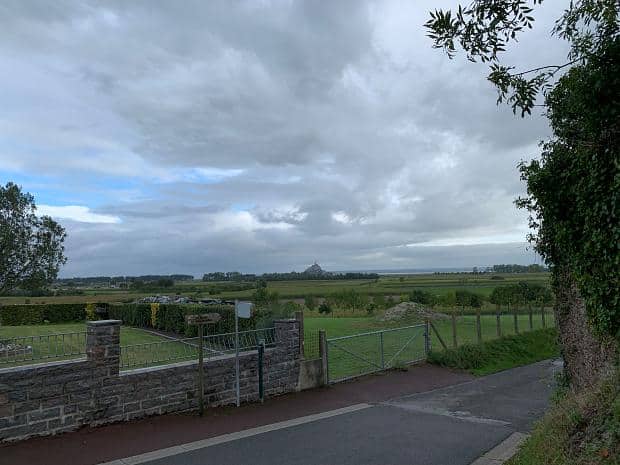

The mudflats are famous in the area and even have a featured spot in the Bayeux Tapestry. We’d been told not to go on them without a guide as there was quicksand. There were guided groups heading out and an organised group on horseback as well, but there were also couples and single people ignoring the advice and heading out across the mud. They did tend to stay close to the town walls though.
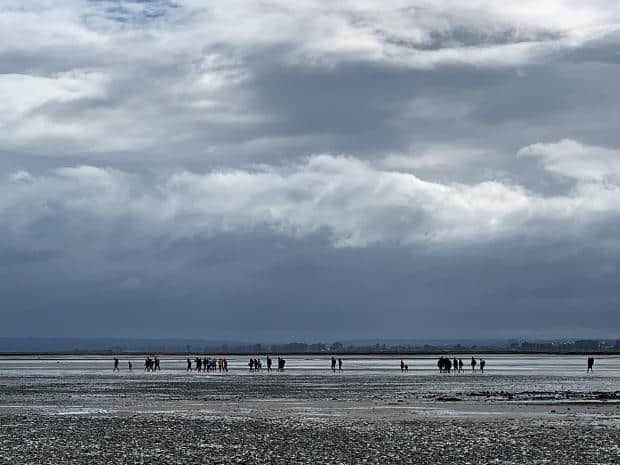
We entered the town and followed the only road, Ange asking if this was the way. I told her that there was only really one way and it lead up to the Abbey, so we followed a group of well-armed soldiers through the tourist trap shops and made our way up the cobbled street to the ticket office.
The man at the counter apologised and said that there were no guides available because of Covid so I turned to Ange and told her that I would fill the gap. I’d last been to MSM ten years ago, but I assured her I still knew all the facts and figures.
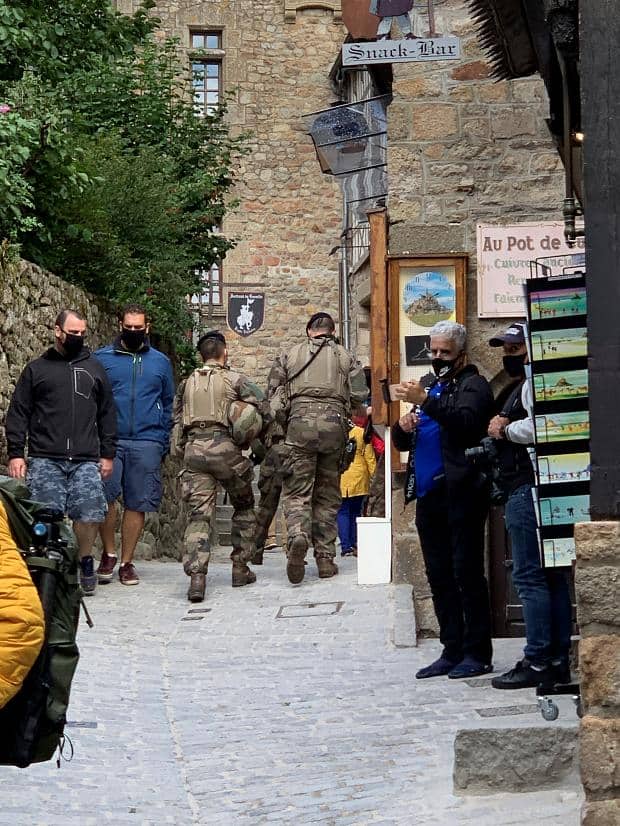

From the top you could get the sense of grandeur that being on the highest point in kilometres in every direction brings. You could appreciate just how quickly the tide would have to travel to cover all the bay four times in a day, and I regaled Ange with (made up) statistics of how many tourists and horses they lose every year to the quicksands in the bay.
Photos like the one below helped in my graphic tales of ultimately doomed rescue attempts and how sometimes whole rows of cyclists on mountain bikes disappeared into the mud never to be seen again. At night, I told her, you can sometimes hear them ringing their bells forlornly from the other side…ring ring! ring ring!
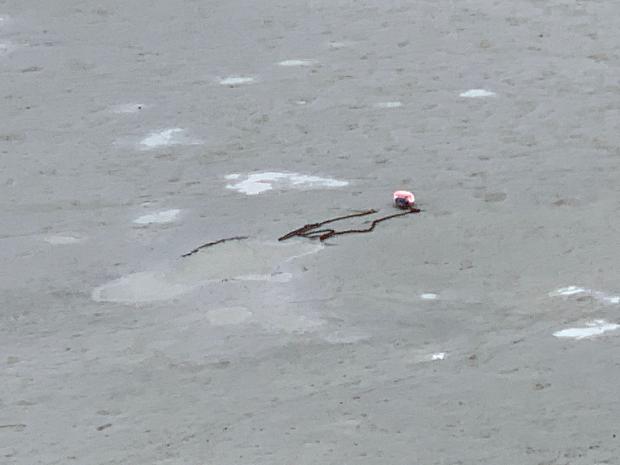
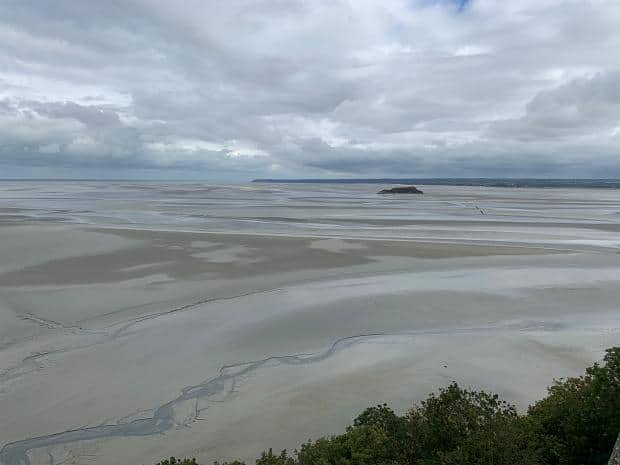
The shells were a motif woven into the decorations on the Abbey, indicative of the fact that MSM was a stop in the Camino de Santiago which we’d discovered in Saint Guilhelm le Désert.
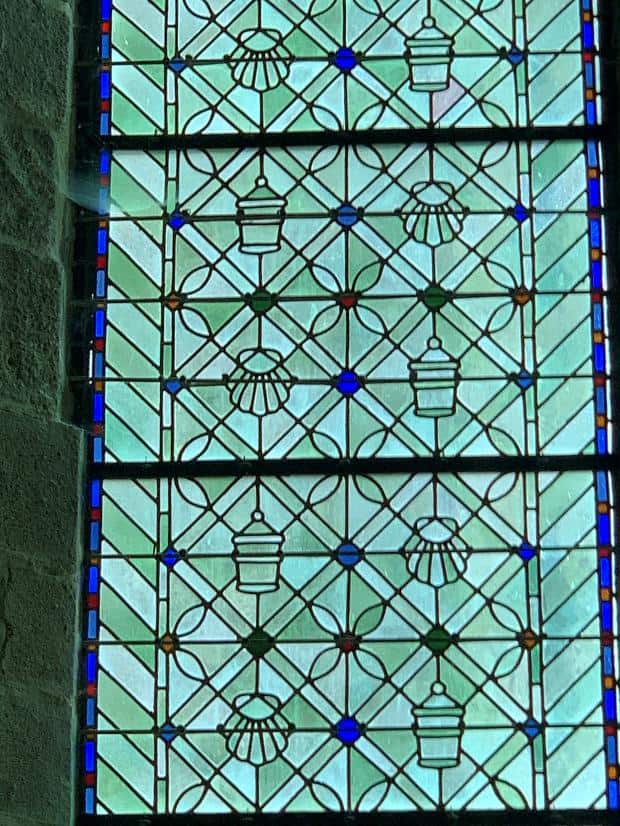
The French hold MSM as a symbol of national pride because it never fell to the English in the Hundred Year’s War. You can see why, with the steep roads, thick walls and imposing battlements, it would be very easy to defend.

Ten years ago the causeway didn’t exist and the tour buses would drive all the way to the base of the town before dropping off their passengers and then driving back across the causeway in case they got stuck.
Now the buses park in the carpark and everybody walks, cycles or comes on the free shuttle. The causeway means that it is only in the highest of high tides that you can’t access the town.

At the top the Abbey’s cloister used to have honey bees and a proper garden, very handy for waiting out those long medieval sieges.
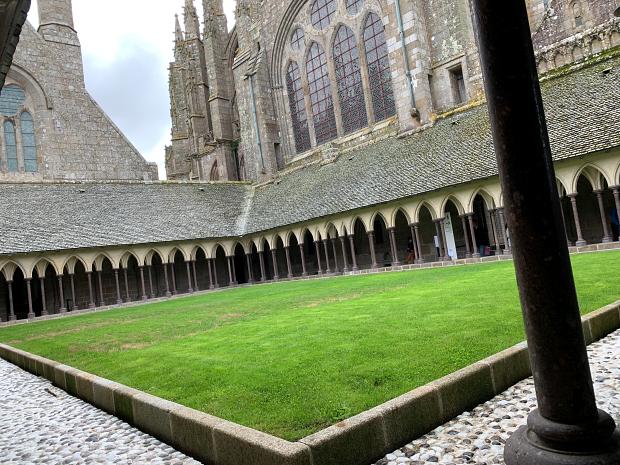
It was amusing for us that the Abbey let you select whether you wanted to exit through the gift shop or not – both staircases ending on the floor with the gift shop, but one at the beginning of it and one just after the cashiers.
Most attractions we’d been to had taken commercial advantage of the flow of visitors and channeled them all through the gift shop to try and squeeze what they could out of them so it was unusual to see an attraction forego this.
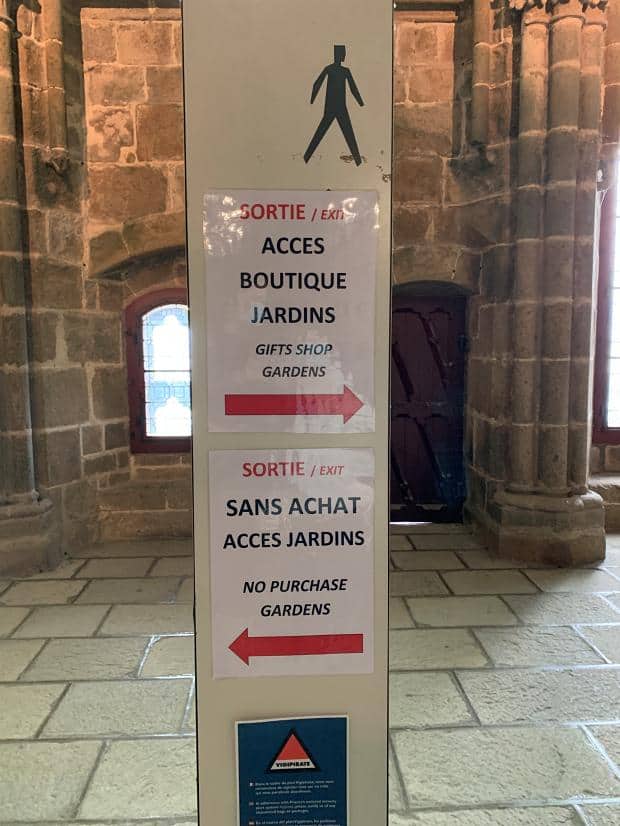
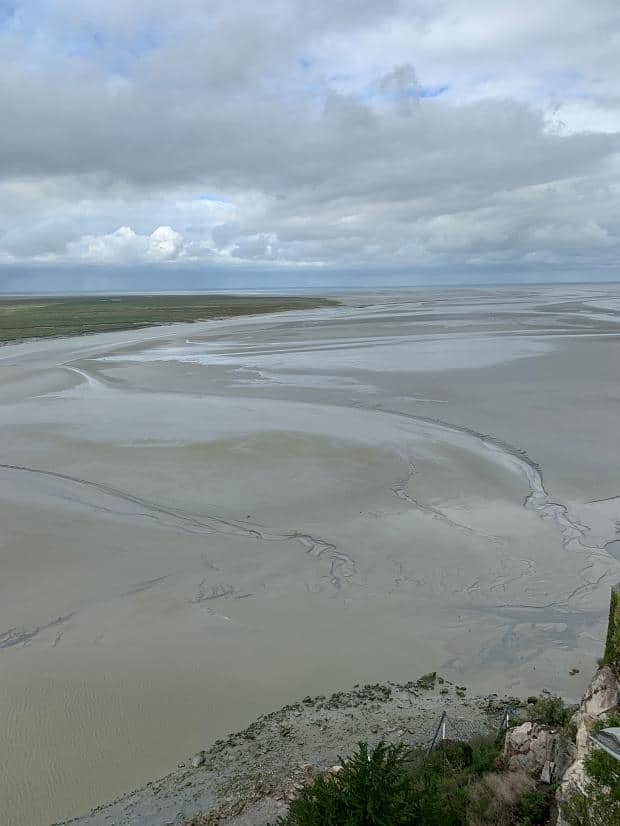
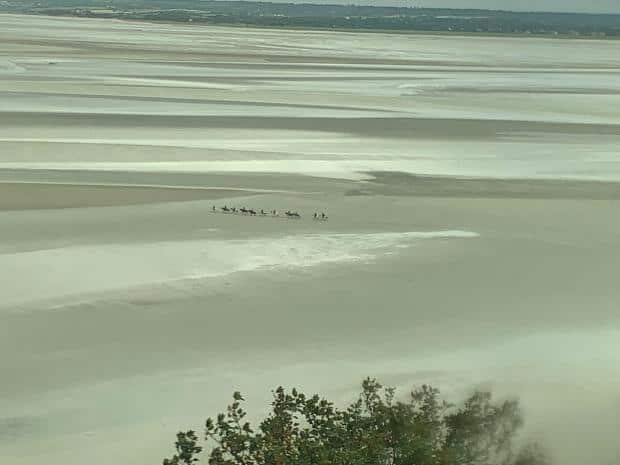

We descended via the town walls, past the restaurants who actually have views out across the mudflats (and charge an extra couple of Euro per meal for the pleasure) and back down into the town proper.
We thought ourselves quite clever to select a crêperie on the 1st floor, the stairs hidden within yet another tacky tourist tat shop. When we got there it wasn’t quite full but getting close and we realised that everyone else was swarming to anywhere which was reasonably priced. The crepes were delicious!

Afterwards we made our way back to the hotel, this time instead of cutting through farmland between the free shuttle drop off and Beauvoir, we walked along the canal instead, passed frequently by cyclists on their way to or from MSM, some on ebikes with a thicker frame or battery poking out the back.
For dinner we tried one of the many restaurants in La Greve, all clustered around the main road joining MSM with Pontorson where the train station was.
The bridge across the canal was one way and it was mildly amusing watching one or other of the cars on the bridge having to back up after realising that the oncoming cars had right of way and weren’t budging.
The meal itself was great with a balance of burger and fries with just a nod to a salad. The local cider was delicious and cheap – always a dangerous combination!

On the way home the country lane between La Greve and Beauvoir was lit by sunlight fighting its way through the clouds, which was quite picturesque.
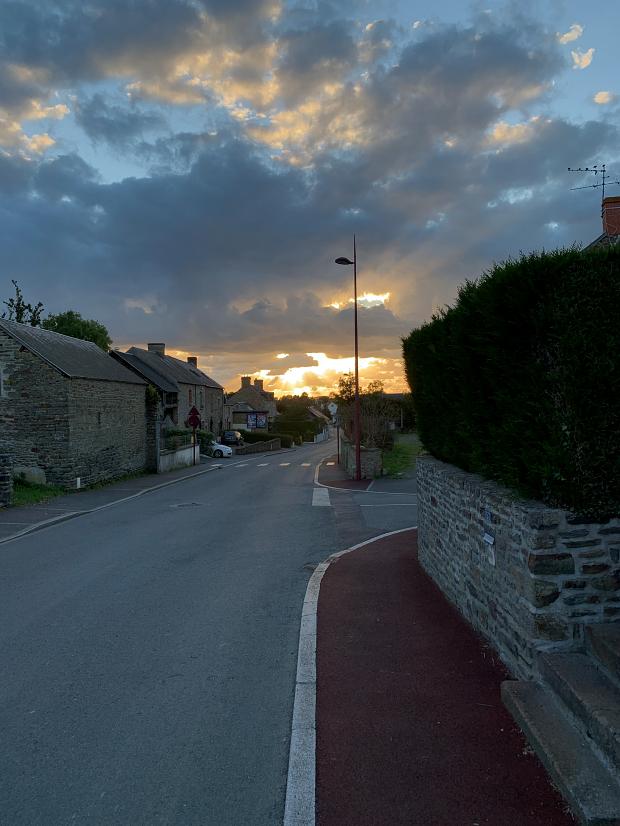
Pontorson
The next day we had a choice. And not really a good one. We had a fair few hours to wait for our train from Pontorson to Bayeux, but there was very little to do in any of La Greve, Beauvoir or Pontorson. So we decided to head into Pontorson by bus and hang out until the train came.
We started off wandering the streets of Pontorson looking at all the restaurants and weighing up whether to go inside. It was a Sunday afternoon and the whole country pretty much shuts up between 2 and 5, so we were lucky to find something that was still open and at the right price point. Ange finally got her own bowl of moules et frites (she’d previously just tried mine) and could see what the fuss was about.

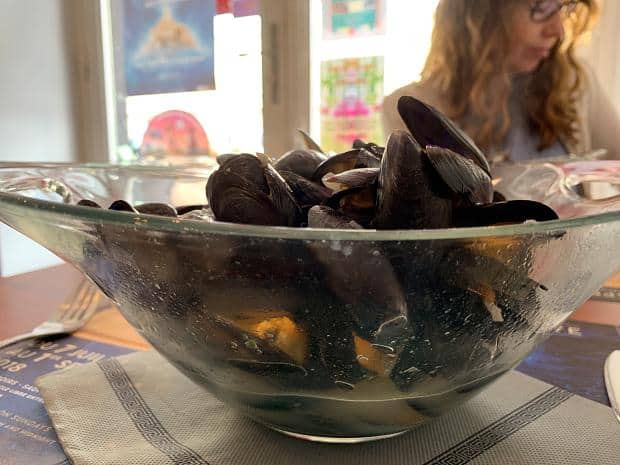
We soaked up a bit more time later on in the afternoon by going to the local chocolate shop for a cup of tea (Ange) and the Cafe Gourmand (me) – an espresso with jug of warm milk, served in an edible, chocolate-lined cup followed by a pair of chocolates and a macaroon. Fun to eat and quite delicious!
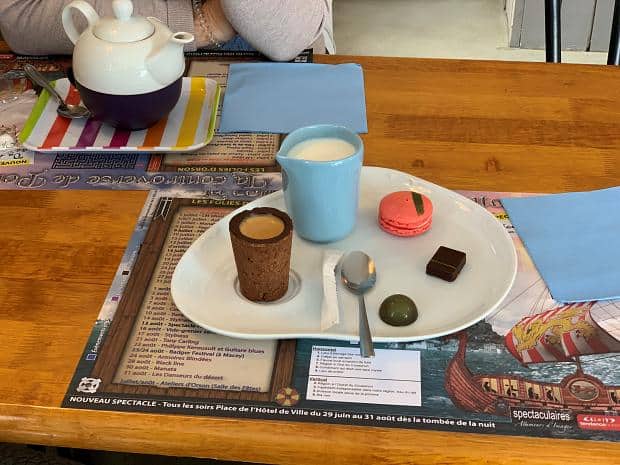
Eventually the time came for the train and we headed on for the next stop, Bayeux. We had searched for other ways to get to Bayeux, but whether it was because of Covid, or because it was Sunday, there were no other options available.
Bayeux
After checking into the Churchill Hotel, we went to a nearby restaurant (La Table du Terroir) and enjoyed a late dinner. I had the Terroir Burger while Ange had the vegetable soup. Terroir in this case referring to the influence of the environment (soil and weather etc) on the food rather than “terror”.
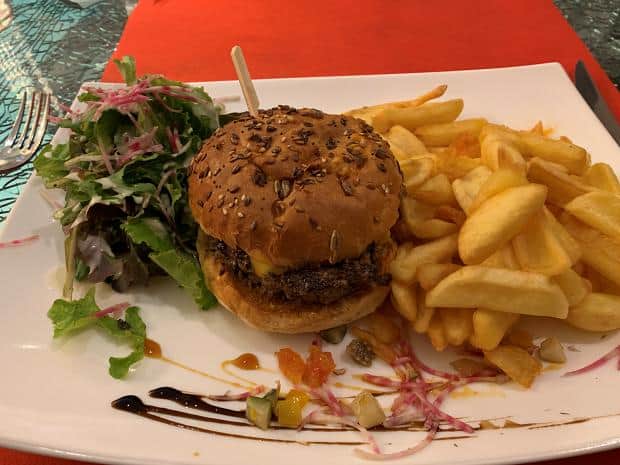
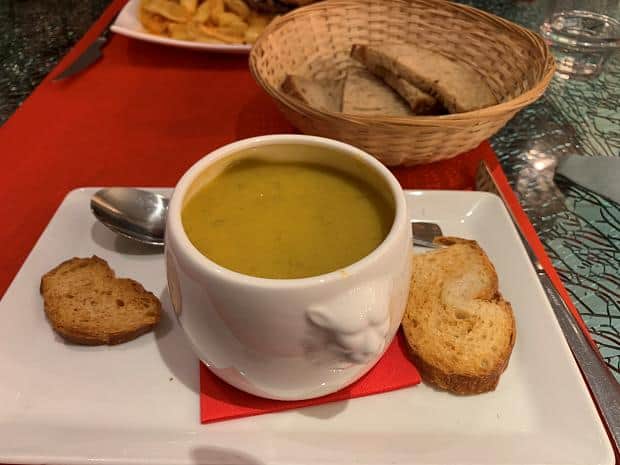
The next day we headed out for an organised tour of the D-Day beaches, returning in the early evening.
This time we went further afield for something to eat. We ended up at a place called La Marsala where I had a pizza and Ange had the vegetarian pasta.
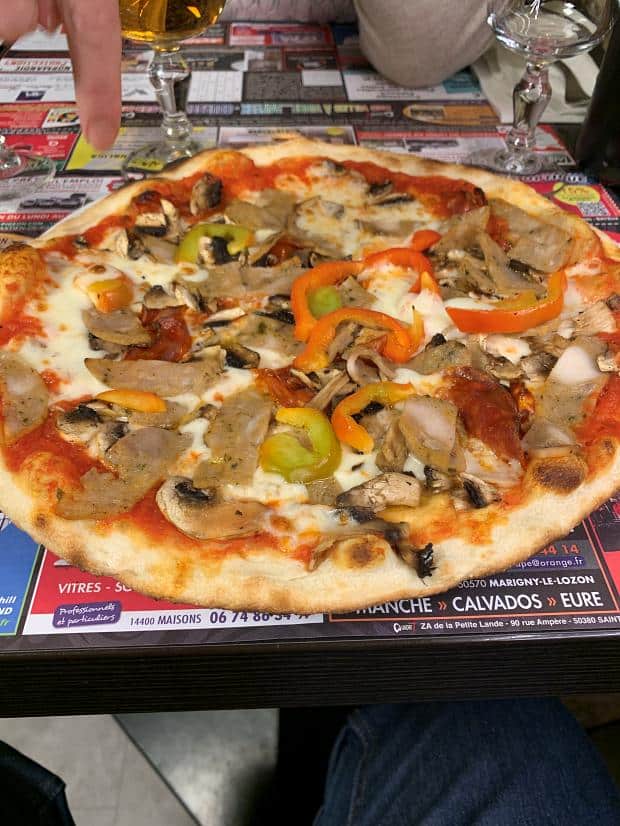
For desert she had the strawberry sorbet but I asked for the profiteroles. For some reason I expected to get a little pyramid of them, and so when I asked how many were in the serving and they responded that there were two, my face must have fallen.
For the price, two little profiteroles would have to taste pretty amazing to be value of money. I needn’t have worried though: when they did come there were two profiteroles, yes, but they were of such a size and accompanied by so much cream that I was well satisfied.
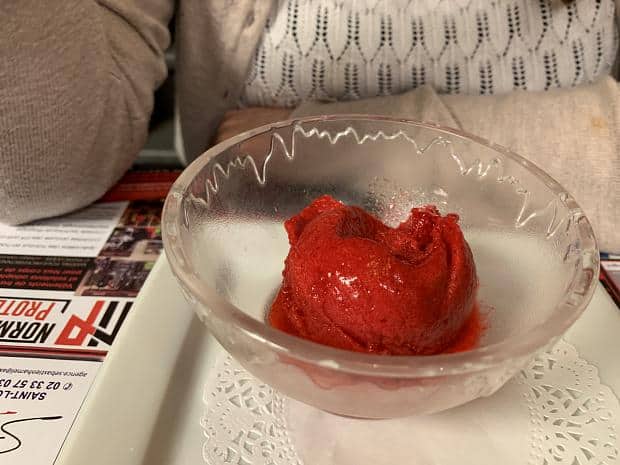

The following day the bus time table ticked over to the winter schedule, and whether it was that or Covid, there wasn’t much public transport access to the D-Day beaches – two buses out to the Eastern three beaches (Gold, Sword and Juno) each day.
Our research didn’t look very appealing so we headed over to the Information Centre and they confirmed what we’d come up with on the local bus service. We decided to check out the local Cathedral while we were waiting for the bus out to Arromanches/Gold Beach.
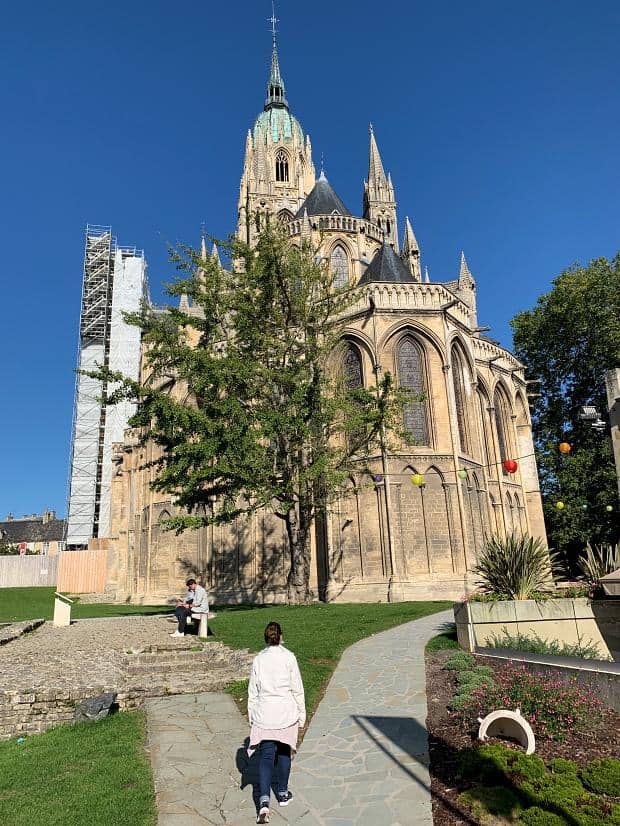
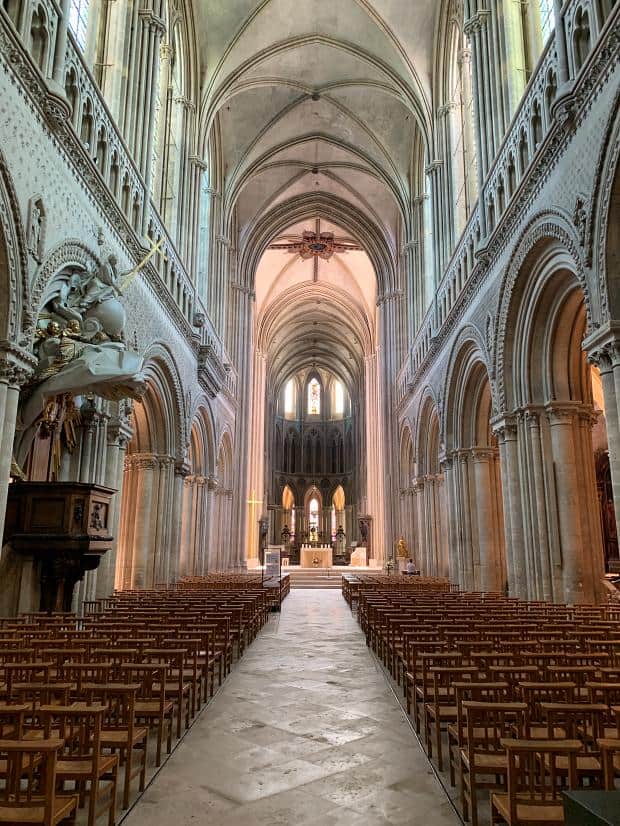
On the way to the bus stop we found a vending machine offering fresh pizza in three minutes, which we thought was a good solution for fast food under Covid.
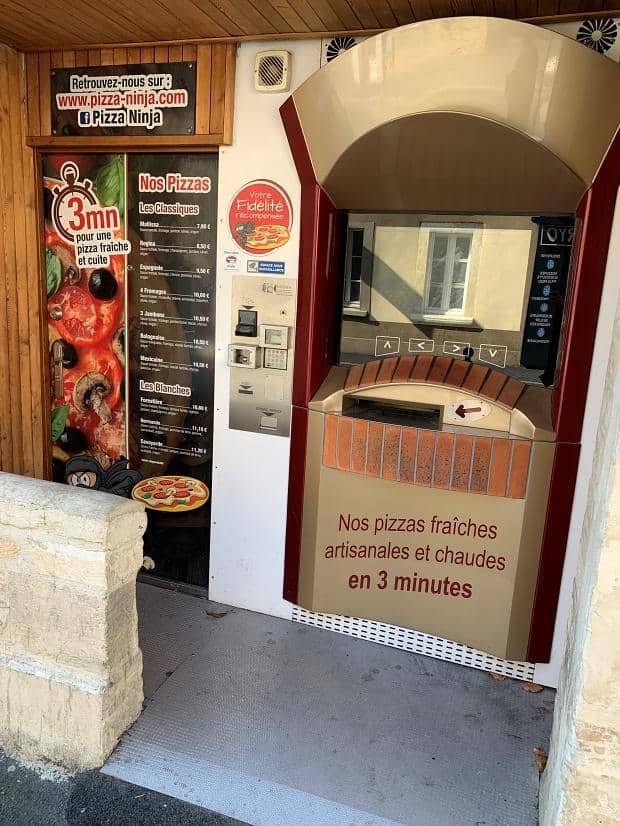
Arromanches 360
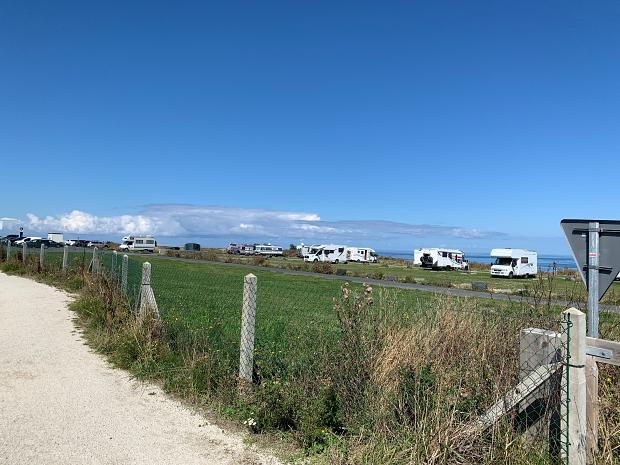
The headlands overlooking Gold Beach are now a camping site for RV and campervans. The spectacular view of the sea with the remnants of the Mulberry temporary harbour in the foreground must make a stunning view, especially with the sun rising or setting on the horizon.
We got off the bus at the 360 Cinema which we realised was a great idea, given the steepness of the hill up from the township and the heat of the day.
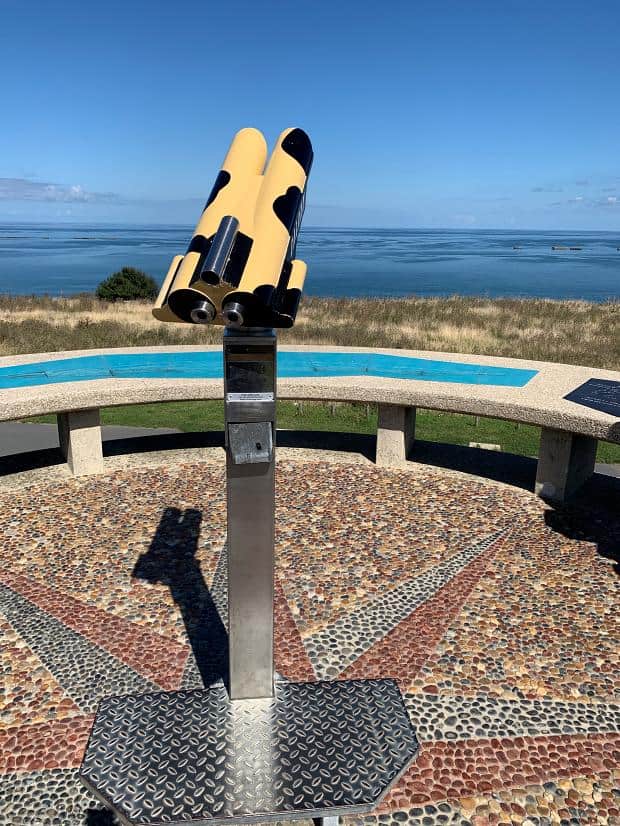
Overlooking the beaches was an observation point, built on top of a pillbox which had been converted into a toilet.
Nearby part of the floating jetty showed what the Mulberry portable harbour consisted of – imagine if you would hundreds of these pointing out into the harbour in four fingers with trucks driving along them laden with supplies.

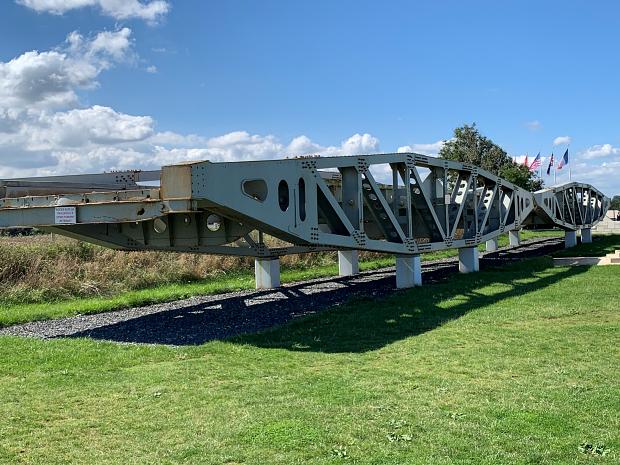
Getting closer to the cinema we passed the D-Day 75 Garden which had first been unveiled at the Royal Chelsea Flower Show. The fleetingness of life was very well represented by the medium of wire mesh with the bodies seeming to fade away as you walked around them.
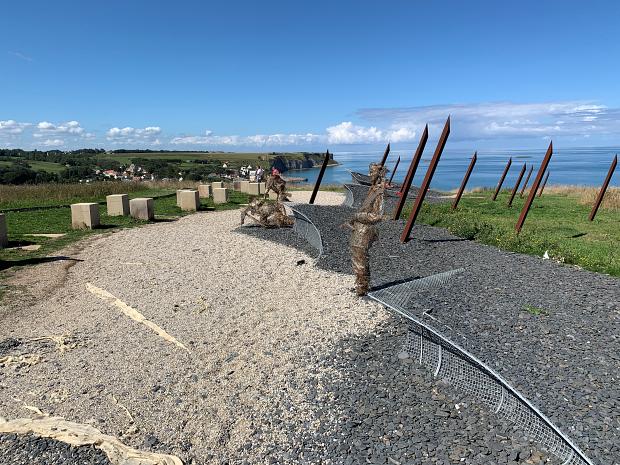

The actual Arromanches 360 cinema is a nine screen standing experience which shows the story of the 100 days of the Normandy campaign. It’s a bit distracting having the screens covering all 360 degrees – I was always wondering if I was missing something going on behind me!
The movies themselves are well worth the trip – very informative, but worrying. The combat footage indicated that some poor camera person was filming the soldiers while they were under fire. Can you imagine the conversation with Health and Safety if that happened today?
“So there will be people who are shooting at you while you try to film?”
“Yes”
“Hmm.. that sounds like it might be a little dangerous… could you hold up a sign or something to say that you’re filming and not to shoot? Or maybe do your filming when they’re not there?”
Anyway, hats off to the Cinema for securing such good footage – it’s the closest we can get to see what it was like during those fateful 100 days. And it really brings to light just what an engineering feat it was with the Mulberrys.

Our Arromanches 360 visit was supported by Laurent and Laetitia at Arromanches 360 and Fran at Normandy Tourism.
After the Cinema, we headed down the hill to the town of Arromanches. The path was incredibly well signposted and seeing it was downhill, it was easy going. At the bottom of the hill we elected to head to the beach. We were lucky with the tide and we could walk right up to the floating concrete blocks which formed part of the harbour.

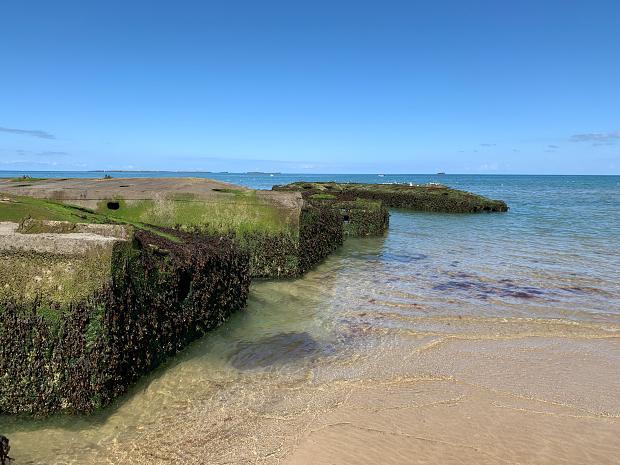

I was glad that they left the remnants here, it allowed you to fill the gaps and see the scale of the exercise. We tried to get into the Musée du Débarquement but after standing in a line for 20 minutes with no indication of what was causing the delay, or the expected time we’d be able to enter, we decided to cut our losses and explore the rest of the town.
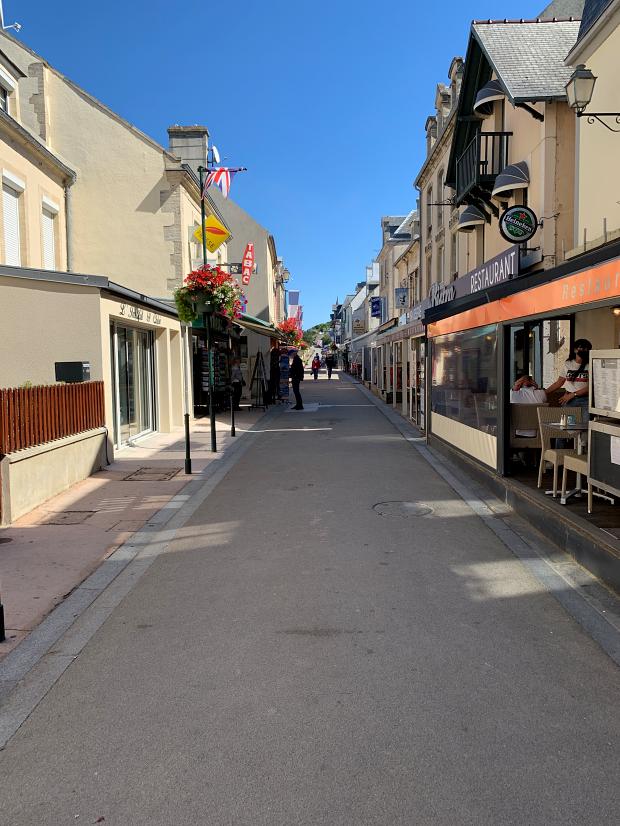
The town itself had the familiar sleepy feeling of a holiday resort – clothing stores interspersed with restaurants of various price points. We walked the length of the main road in no time and then I grabbed an ice cream (double wafer cone – peanut and banana/chocolate) and we thought about how we were going to get to the next beach.
The second bus eastward would be coming through at the same time as the last bus westward, so we couldn’t wait for that one – the plan was for us to take a taxi to Juno Beach. The taxi rank was right there in the main square, but when I rang them the lady answering the phone indicated that it would be two hours before the driver would be able to take us. I shrugged, thanked her and checked Uber. We got very lucky and found a driver 10 minutes away who would be able to take us.
Juno Beach Centre
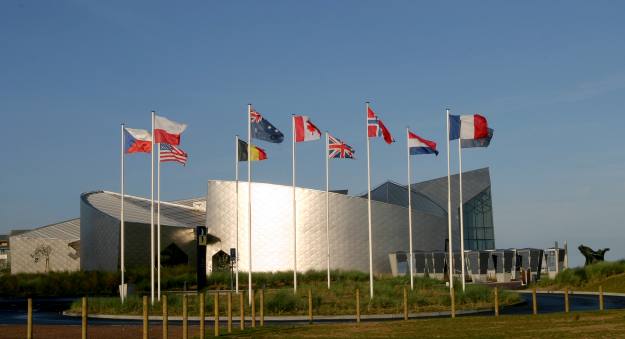
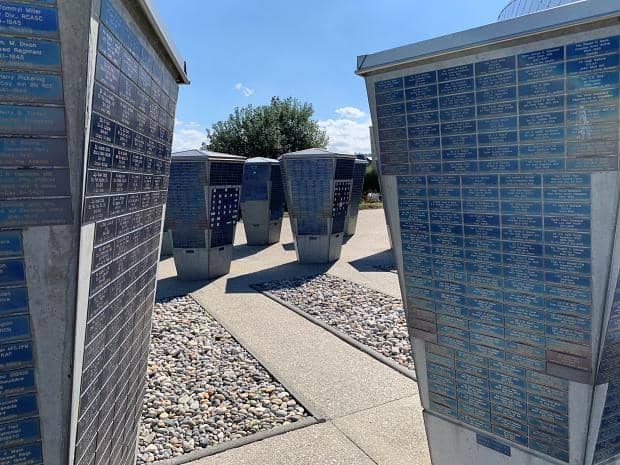
Half an hour later Murat was dropping us off outside the Juno Beach Centre. Staffed exclusively by Canadians, the centre does a wonderful job of explaining the context behind the Canadian involvement in World War Two.
It starts off in the 1930s explaining where the nation was in terms of independence, and covers the maturation of its armed forces from the disasters at Hong Kong and Dieppe, to the closing of the Falaise Pocket and advance on Germany.
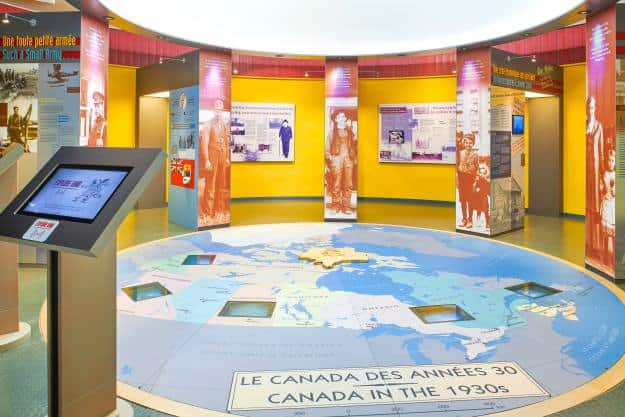
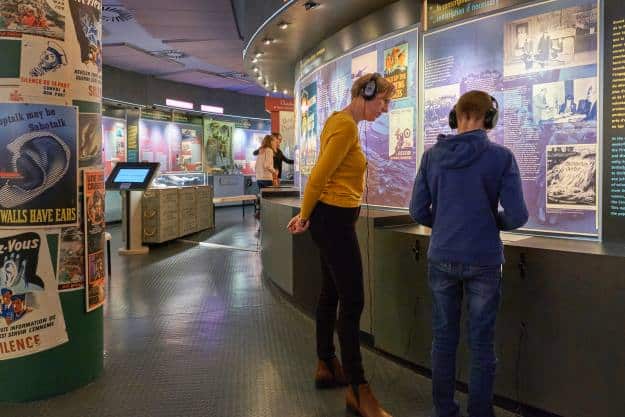
While even under Covid there is plenty to see and experience, they’ve had to remove the more tactile exhibits and displays which is a pity. Despite this there is plenty to keep everyone occupied, and the introductory video showing the mock up of a landing craft is a good way of introducing the experience that the soldiers would have encountered while coming ashore at Juno.
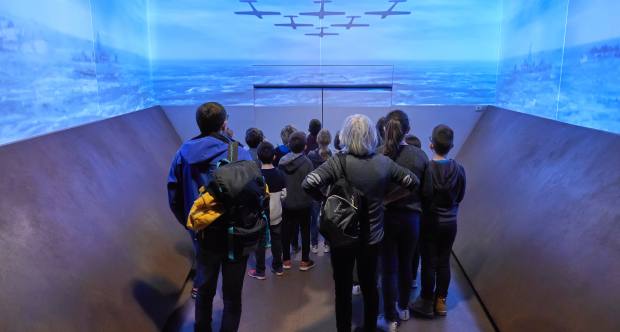
The last sections of the museum’s permanent exhibitions are the most touching with the focus on the service people that didn’t come back plus a video entitled They Walk With You, linking the servicemen who came ashore at Juno with those Canadians alive now.
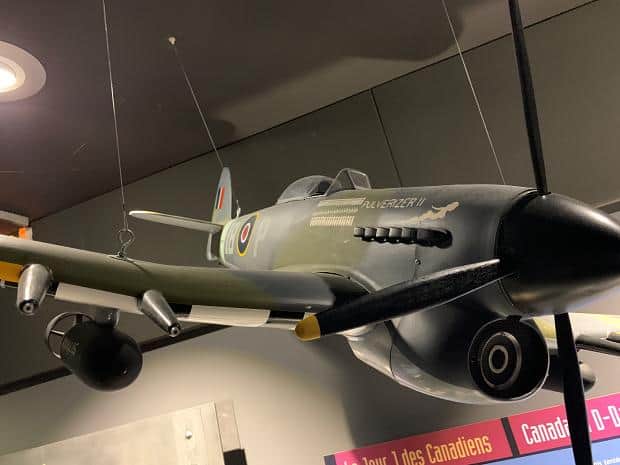
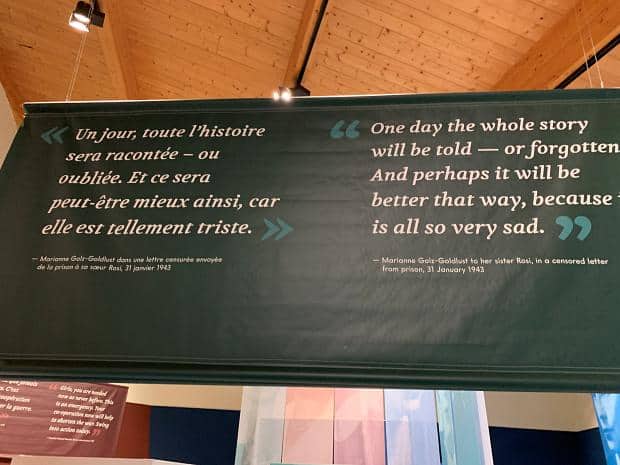
There are a number of temporary exhibits including a spotlight on the stories of Great Women during the War, an eye opening look at the lives of both European and Canadian women during wartime.
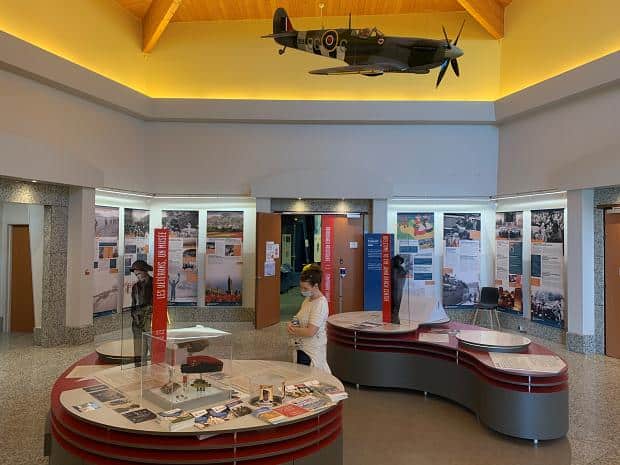

Our Juno Beach Centre visit was supported by Ophélie and Patrick from Juno Beach Centre and Fran at Normandy Tourism.
After visiting the museum at Juno, we had a half hour wait for the last bus to go back to Bayeux. We used the time to check out the beach and the surrounding town of Courseulles-sur-Mer, which had even more monuments and memorials to the Canadian forces during D-Day.
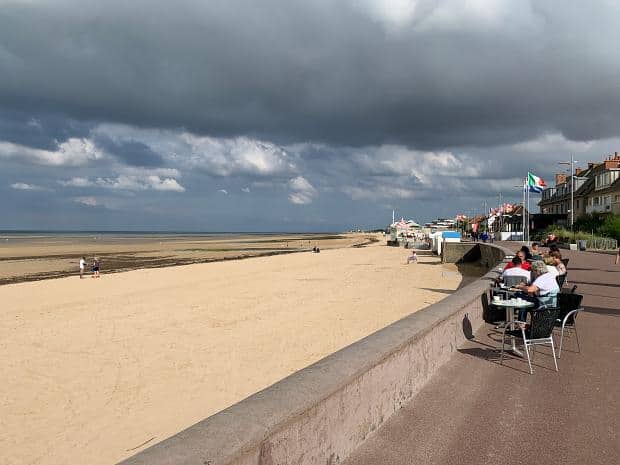
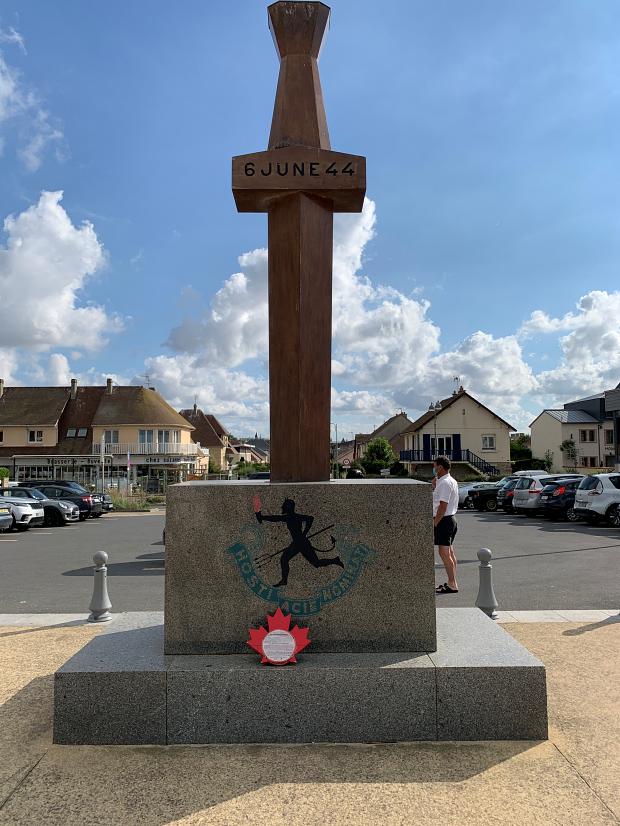

We were starting to get a little worried when the bus was late – it’s hard to have a plan B when you’re in the middle of nowhere with no trains, limited taxi and Uber services, so it was a relief when the bus turned up, a trainee driver behind the wheel supervised by another member of staff.
After an exhausting trip, we found ourselves back at Table du Terroir for another burger, this time we both had the fish burger washed down with a bottle of the same cider we’d had at La Marsala previously.
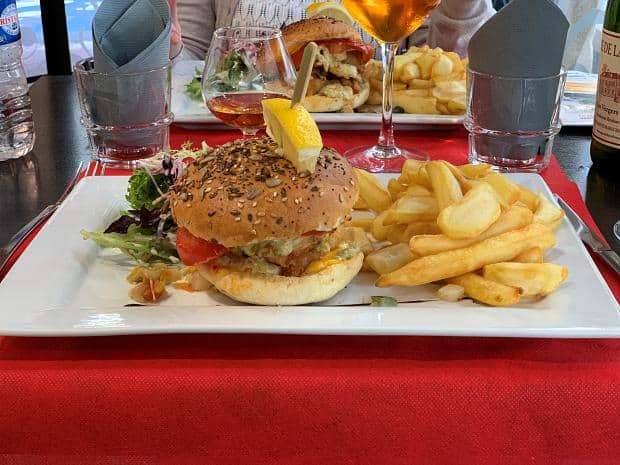
After dinner we headed off to our accommodation: this time Le Château des Monts in the little hamlet just out of Bayeux called Barbeville. The next morning we came back into town after breakfast and dropped our luggage off at the Winston Churchill Hotel in preparation for our last night. Then walked to the station to catch a train to Carentan and the D-Day Experience.

Carentan
The D-Day Experience is not really in Carentan – it’s a 40 minute walk away and given the sun’s strength we decided to grab a cab from the train station to the museum. We were very glad we did – the path alongside the road was denuded of tree cover so we would have gotten sunburnt on the way.
Our petty reservations were brought to light when we discovered that the road to Carentan from Dead Man’s Corner was a hard fought after corridor which was to prove central to the protection of the Western flank of the break out from the D-Day beaches.

The Museum itself is nuts. There’s no other way of describing it. It starts with the house used as a headquarters by first the German Paratroopers and then by their American counterparts. This is where you get your first introduction to the exhibits which are eerie in their realism. They stare through you as they sit or stand in realistic positions with authentic equipment as you read the placards nearby.
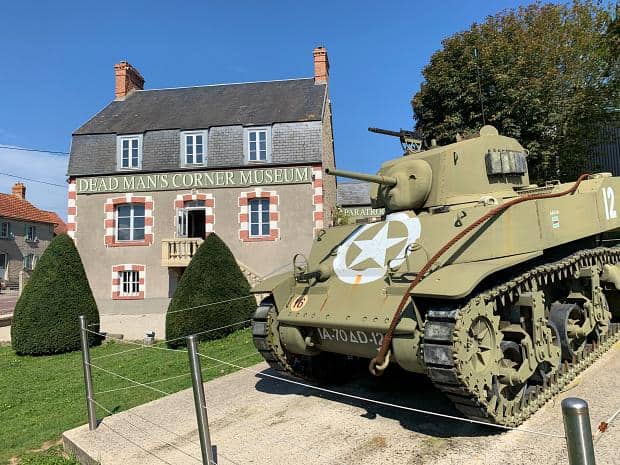

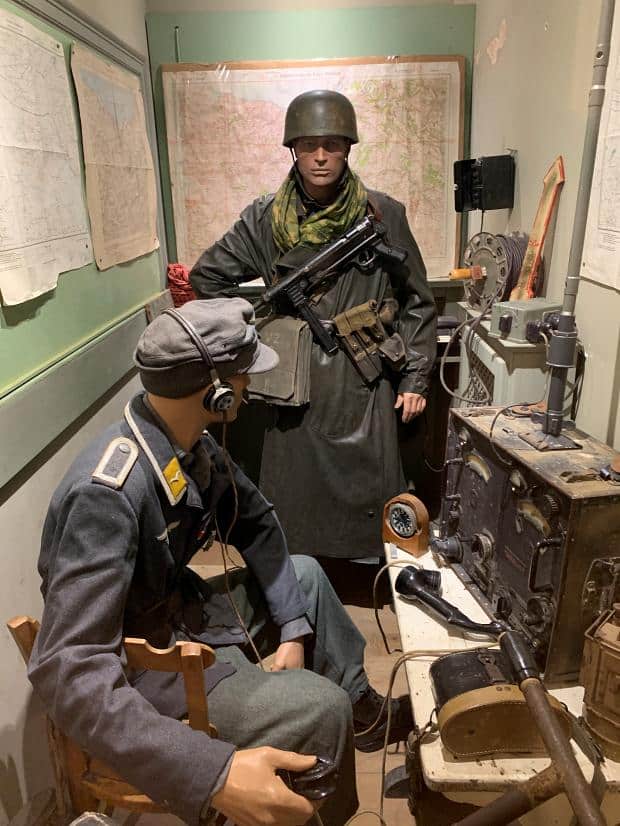
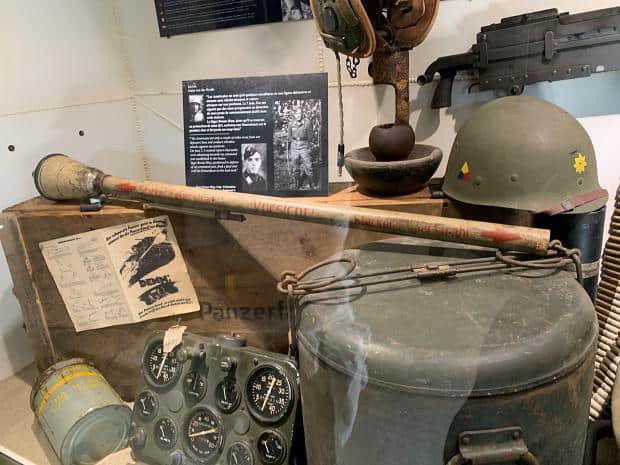
The sheer volume of equipment is astounding. In each exhibit all manner of weapons, equipment and uniforms are displayed with explanations and by the time you’ve looked upstairs and downstairs and head through the saloon type doors, you find yourself in the shop. Not the gift shop, but instead a place where you can buy enough equipment and weapons to costume a whole movie set.
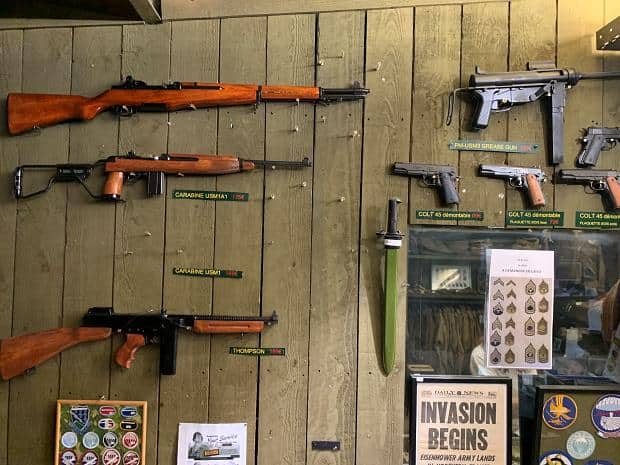
There are weapons, uniforms, badges and emblems, medals and webbing and all manner of equipment, for sale. It feels like a military surplus store on steroids: all the equipment comes with eye watering price tags and are presumably all authentic. I couldn’t imagine paying almost €3k for a German helmet unless it was the real thing.

I can’t imagine who would want to buy a medal though – who would wear an unearned Purple Heart?
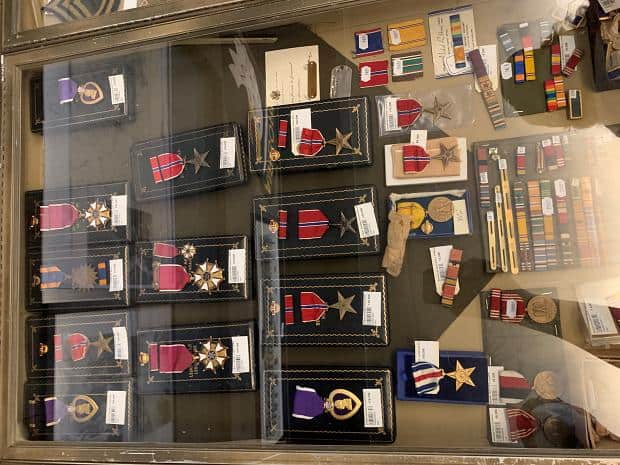
Anyways, it was onto the D-Day Experience inside a real C-47. We sat for a briefing where a holographic officer gave us the low down of what was going to happen and then we all shuffled aboard a genuine C-47 and buckled ourselves in.
I won’t give away the rest of it but let’s just say it did a really good job of showing what it might have been like inside a C-47 leaving England and participating in the drops over the Contentin Peninsular on the night before D-Day.


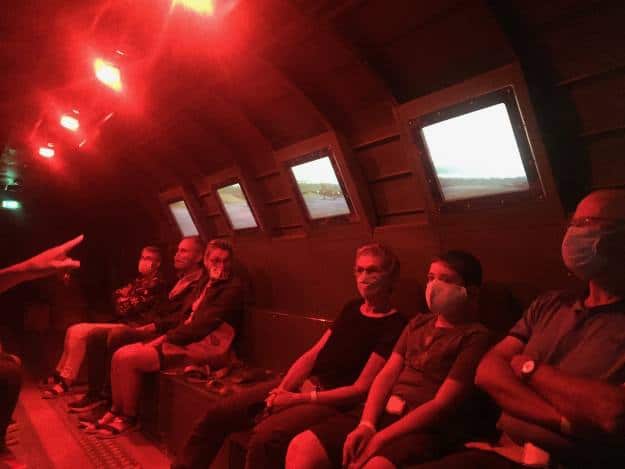
Afterwards we checked out the exhibits. I was fascinated by one describing the paratroopers who took on the hairstyles and face paint of the Mohawk Native Americans. I was pretty sure they would be accused of cultural appropriation now, especially with Cancel Culture.

After that we headed upstairs for more exhibits featuring hyper-realistic mannequins posing in various scenes. The size of these scenes are larger than I’ve seen in other museums and the D-Day Experience must have a huge footprint because they have so many of them as well.
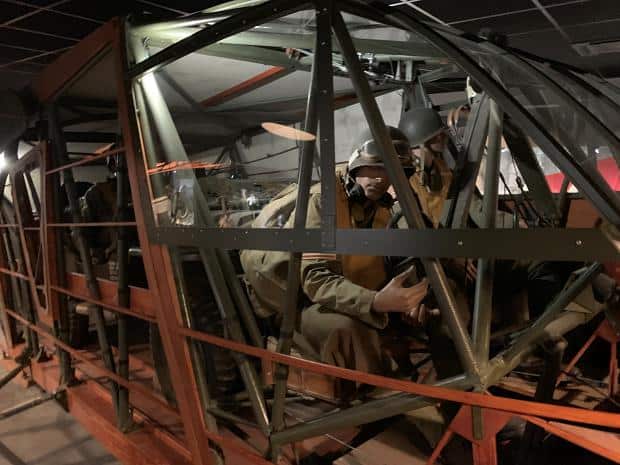

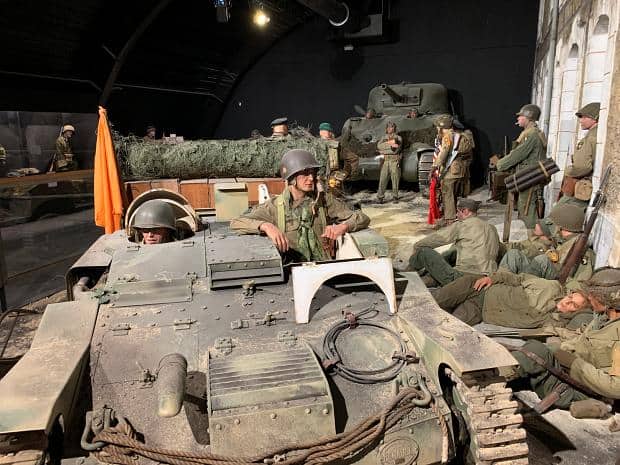
Our final stage of the D-Day Experience was the 3D cinema which showed a a couple of movies illustrating the advancement of the lines during D-Day, and in particular the Battle for Carentan.
The 3D really came into its own with the illustration of planes fighting using an almost Matrix like bullet cam effect. The only downside to this was that the big screen had French commentary while we had headphones dialled into English, so you had to turn the volume up to drown out the French equivalent. It may have been better to have the cinema sound off and for everybody to rely on their individual headphones for the commentary.

Our trip D-Day Experience visit was supported by Aurélie at D-Day Experience and Fran at Normandy Tourism.
The Bayeux Tapestry
We took a cab back to the train station and then returned to Bayeux by train, arriving at about 4 – just enough time for a quick bite from Le Conquerant before heading across to the Bayeux Tapestry Museum.
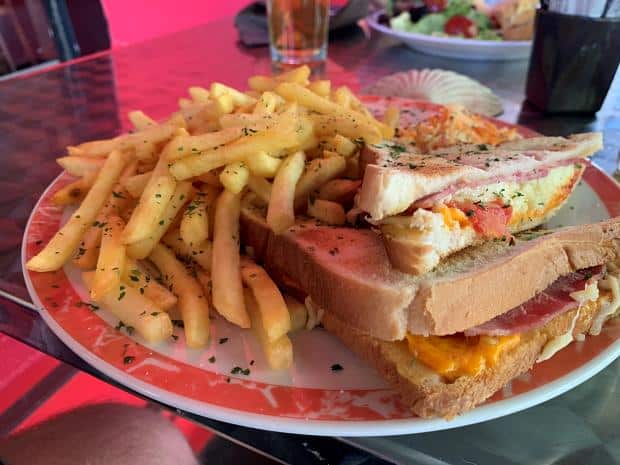
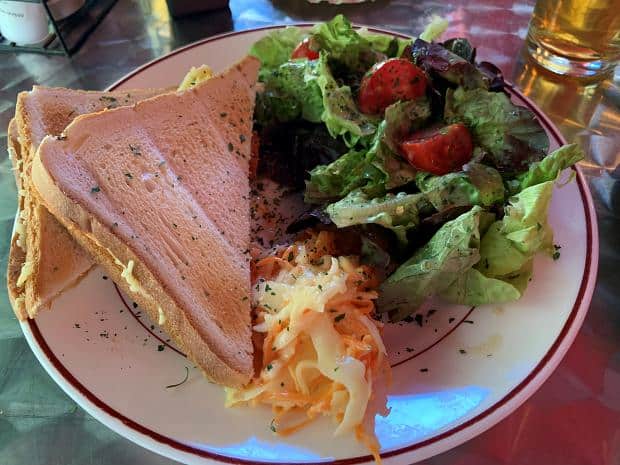
Thanks to Covid there was no queue and we were able to go straight in. The audio guide really is a must because without it you’ll be looking at a medieval embroidery stretching for 70 metres without picking out the meaningful bits, especially if your Latin abilities are, like mine, zero.
No photography allowed, but an entertaining and informative half hour of the story of William, Duke of Normandy’s conquest of England in 1066.
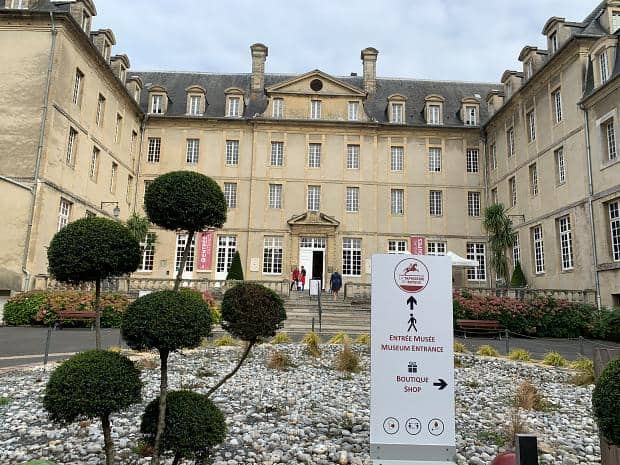
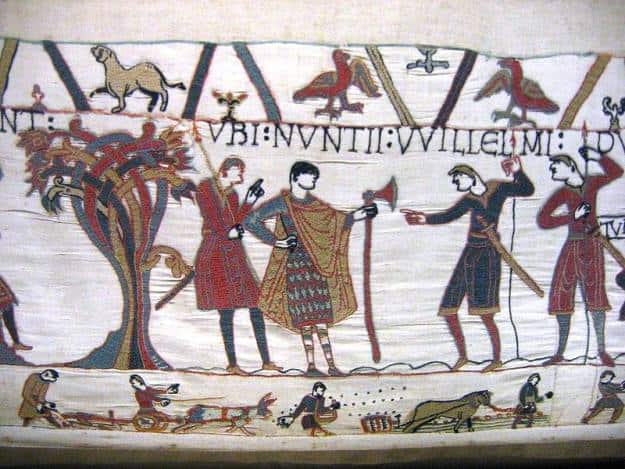

Our Bayeux Tapestry Museum visit was supported by Fanny at Bayeux Tapestry Museum and Fran at Normandy Tourism.
After the Tapestry we took advantage of our proximity to the local Carrefour (supermarket) to buy a salad and a baguette and watched a movie in the hotel room.
On the way home
So on the last day of our trip, we have ample time and have booked tickets on the train with allocated seating. For the first time my SNCF app actually showed the QR code for the trip, so any conductor would be able to scan it and not need to see the booking email. Awesome!
The train trip from Bayeux to Paris St Lazare was supposed to stop briefly in Caen before continuing on, but we stopped there for a while… and then a while longer… and finally after a 30 minute wait I got up to see what was going on.
I went up to the Chef du Gare who was on the platform and he looked up expectantly as I approached. “Hi, uh… what’s going on?” I asked. He didn’t understand my question. “I don’t speak much French and so I haven’t been able to follow the announcements,” I explained.
I think he’d spent 30 minutes getting chewed out by other passengers so he was a little blunt. “We found a bomb,” he said. “We’re not going anywhere for at least two hours.”
“Well, that’s not very good,” I managed, looking at the body language of the other people waiting on the platform. Nobody was panicking, and the fact we’d been there for 30 minutes made me think that there was nothing to worry about.
I pointed to the signage board behind him which indicated that there was another train to Paris coming in at 11:48, about an hour away.
“Will that train be able to take us?” I asked, indicating both the rails that our train currently occupied plus the number of passengers on the platform.
I think that he was surprised I wasn’t holding him personally responsible for the delay, and so he answered that the 11:48 would come into the station on the line on the other side of the platform and that there would be no issue with capacity. I thanked him and went and told Ange the news.
We decided that while there didn’t seem to be any immediate danger, we’d go and use the time to grab some food, stopping at La Consigne across the way from the station. Ange had the soothing soup and I had the calming fromage et jambon baguette and we headed back in time for the 11:48. Which was saying that it was now delayed by an hour and a quarter.
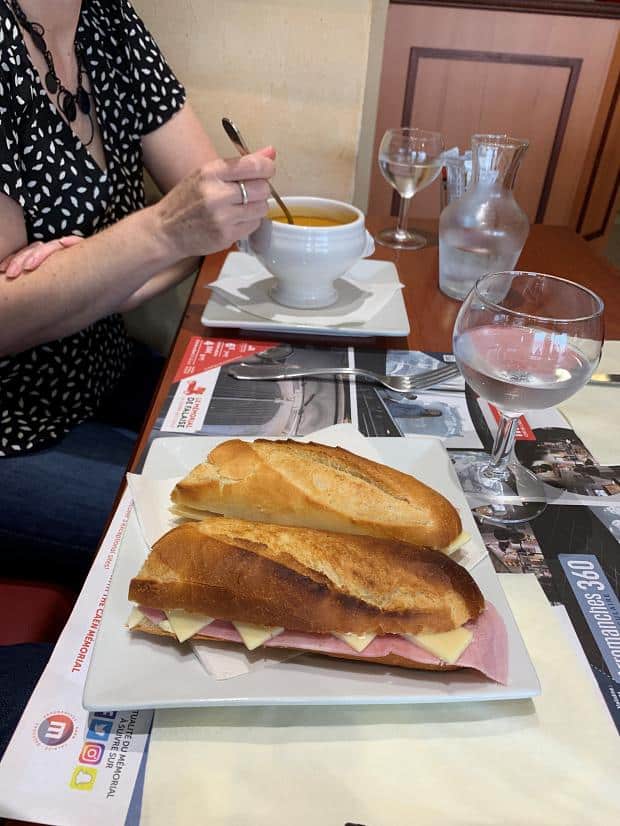
I looked at Ange and we started thinking about backup plans. I saw that the train to Rouen was leaving at about noon, and that if it was halfway between Caen and Paris then maybe we could catch a train to Paris from there.
I was worried that our tickets were for Bayeux to Paris only, so joined a short queue waiting to talk to one of the station staff, and explained our predicament. She said that it was not advisable, not because of the ticket situation, merely that the train from Rouen to Paris would leave four minutes after the train from Caen arrived in Rouen and that wasn’t enough time for the transfer. And most importantly that the 11:48 might be able to arrive earlier.
I relayed all this to Ange and we decided that even though we might be able to grab a cab from Rouen to the airport, it was probably a better option to wait for the 11:48. Not long after the Rouen train left, the signage on the big board indicated that the 11:48 would be now arriving in 20 minutes. A mass of people headed to the platform and we trailed along behind them.
We’d originally planned on taking public transport to the airport from Paris but we didn’t want to have any further delays, so elected to spring for a taxi instead. Paris during lunchtime in the searing afternoon sun was a shock after the gentile tranquility of the countryside towns of Bayeux and Beauvoir.
While masks were everywhere, there really wasn’t much social distancing going on – maybe because everyone was safely isolating in their cars?
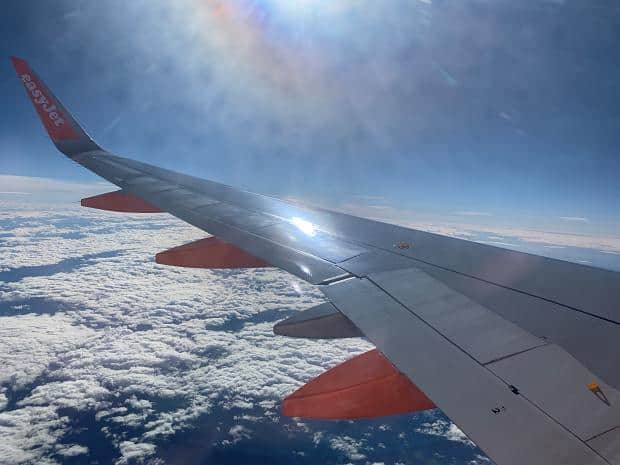
Anyway, we made it to the terminal and to our gate without any further incident, taking off in lovely sun and flying above the clouds all the way up the body of the UK, before poking down through the cloud cover (with a few bumps) and seeing the welcoming sight of Edinburgh.

After landing and crossing the tarmac by foot and feeling the first drops of rain starting because our carrier didn’t want to spend any money on an air bridge, we zoomed through passport control and waited for our bus to come.
Just then the heavens opened and a biblical downpour ensued, which we watched from the dryness of our shelter. Ten minutes before our bus arrived, the rain stopped and the storm passed over towards the city and we watched a gorgeous rainbow follow in its wake, an obvious ray of hope after the darkness of the storm.
